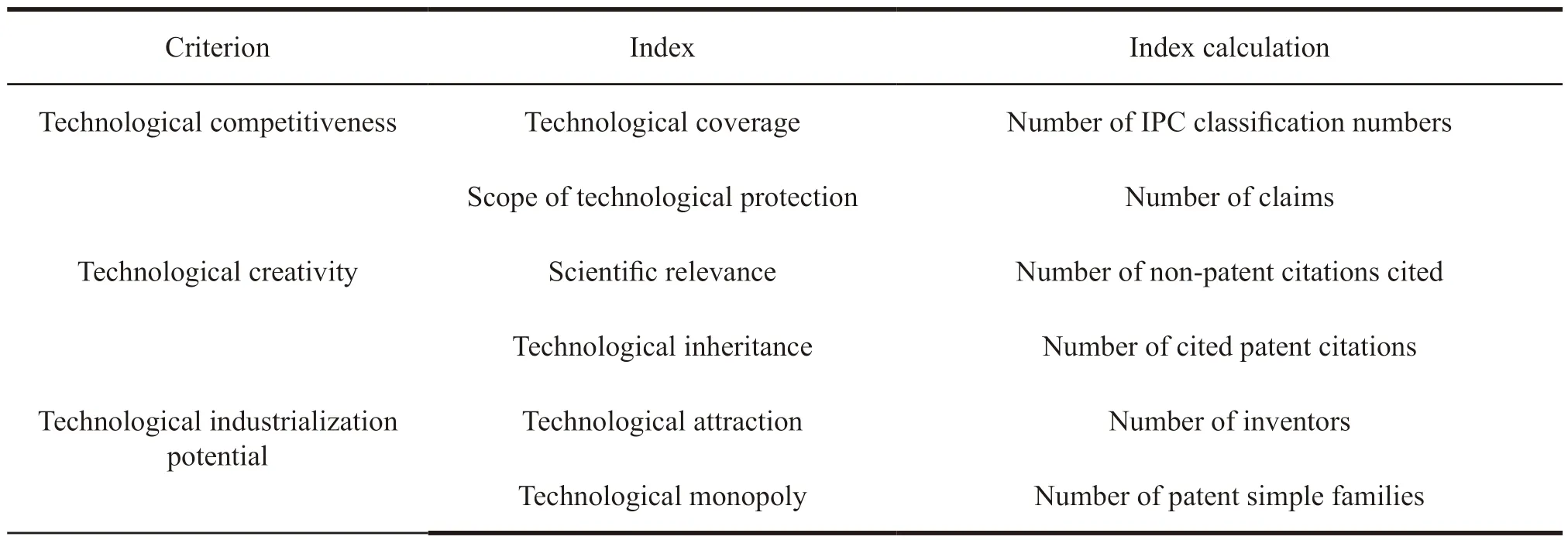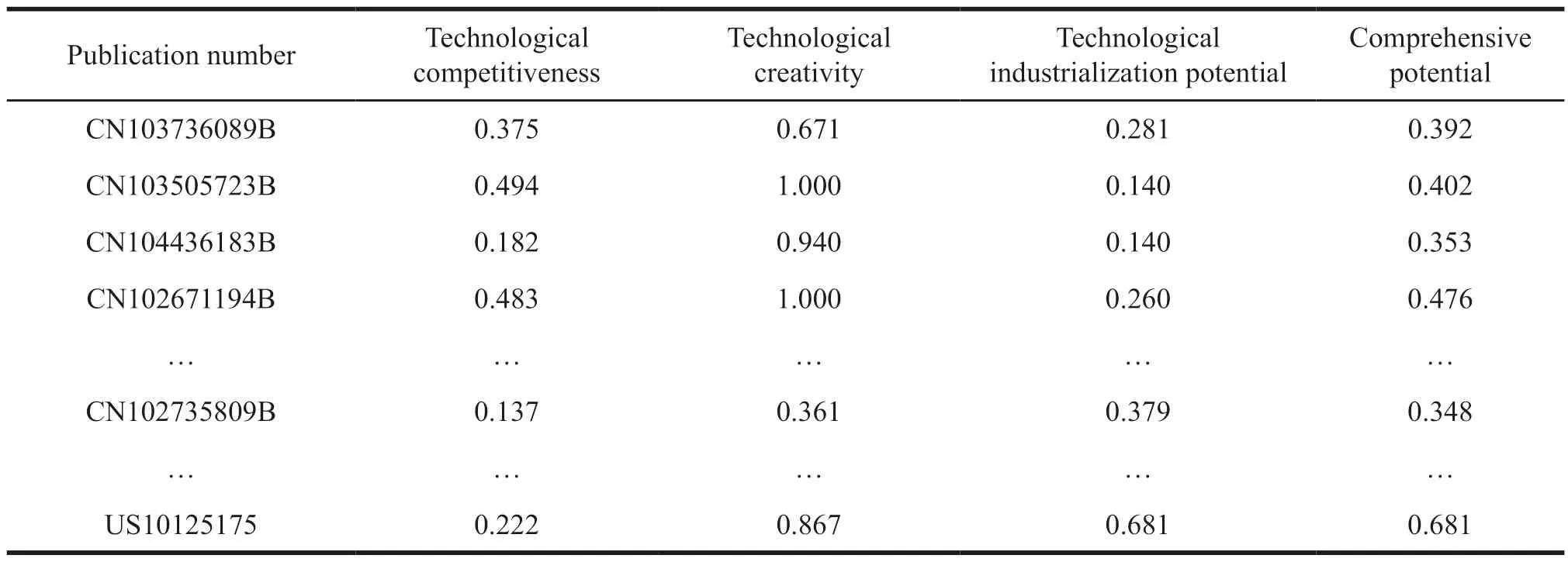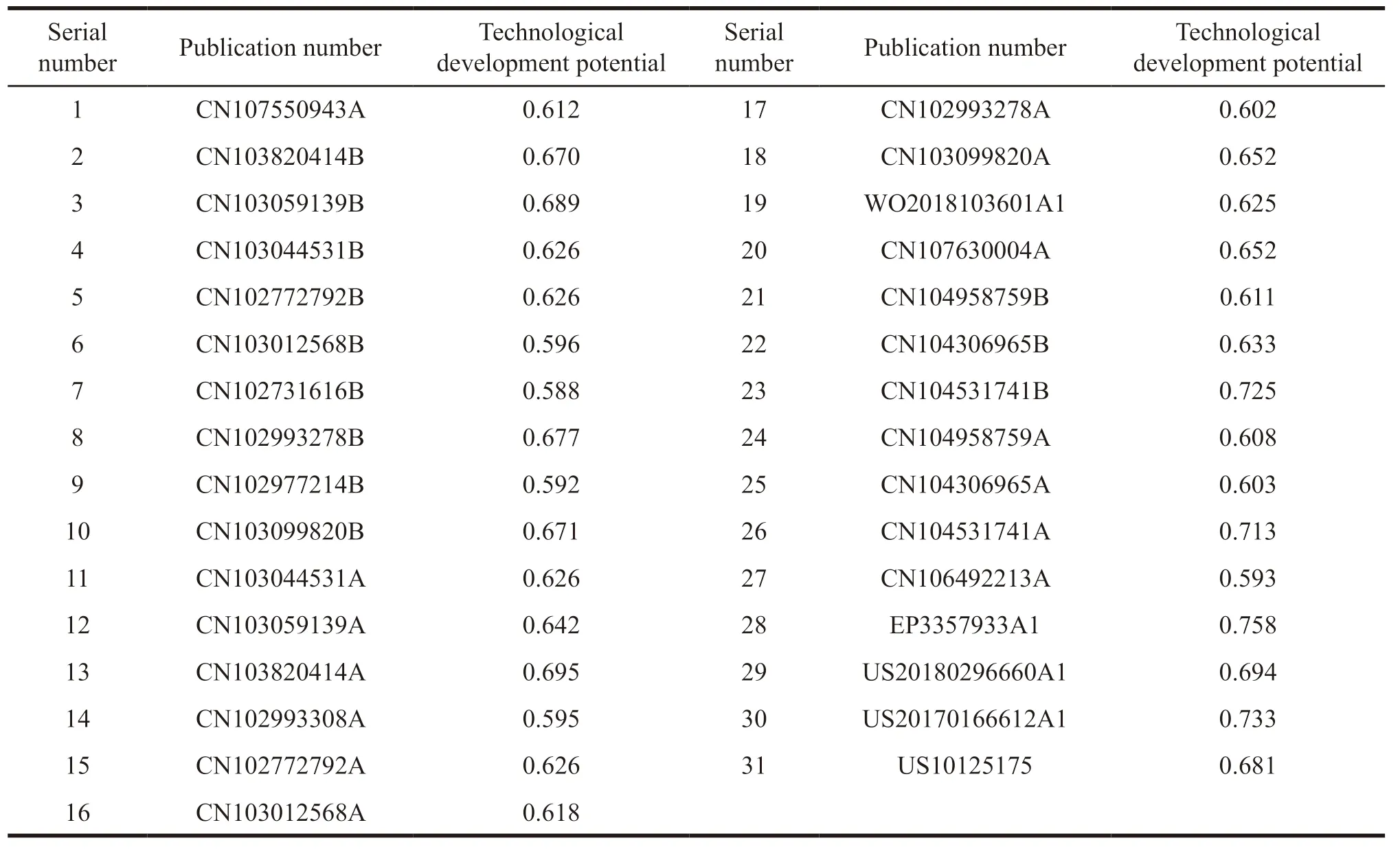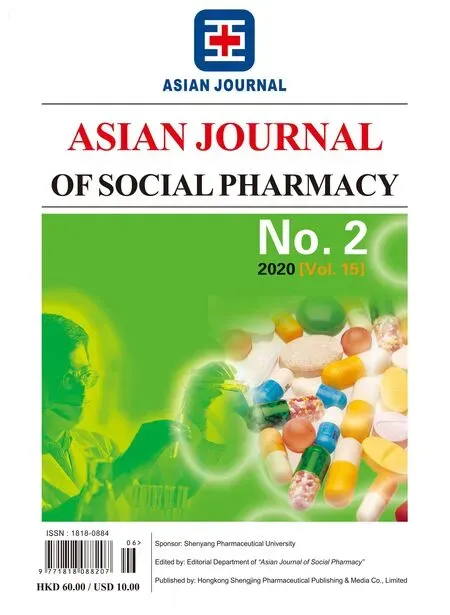Research on Technology Opportunity ldentification of Small andMedium-sized Vaccine Enterprises Based on Patent Analysis
2020-06-23ZhangWenfengFengXinYuanHongmei
Zhang Wenfeng,Feng Xin,Yuan Hongmei*
(School of Business Administration,Shenyang Pharmaceutical University,Shenyang 110016,China)
Abstract Objective To propose a method for identifying cooperation partners and technology opportunities based on technological similarity and technological capability analysis at the critical moment for the survival of small and medium-sized vaccine companies.This method can provide a direction for small and medium-sized enterprises that lack human and financial resources to make full use of its existing technologies.Methods Data analysis was carried out based on patent data.First,through cosine similarity and patent index evaluation,companies with high technological similarity and strong technological capabilities were selected as the target of cooperation.Then evaluation index system of technological development potential was built from three dimensions:technological competitiveness,technological creativity,and potential for industrialization.AHP-CRITIC method was used to determine the comprehensive development potential of each technology.Finally,technology opportunities based on K-means and text mining were identified.Results and Conclusion This method can help small and medium vaccine companies in China to identify technological opportunities and provide directions for product development.
Keywords:small and medium vaccine enterprise; technology opportunity identification; cooperation partners;technological similarity; technological innovation capability; patent analysis
The vaccine scandal of Changsheng Biotechnology Co.,Ltd.accelerated the introduction of Vaccine Management Law.It will further speed up the scale and intensification of the industry.Smaller enterprises that lack technological advantages will be phased out gradually.In this context,small and medium-sized vaccine enterprises should strengthen cooperation with each other,enhancing product quality standards and the ability of innovation.Under the premise and the basis of technological innovation,technological opportunities have opened a window for technological development.However,technological opportunities require an in-depth exploration of dynamic scientific and technological information through specific technological means.
Early identification methods of technological opportunities are mainly based on experts’ qualitative analysis,such as the Delphi method[1-2].With the rapid changes in the market environment,the dispersion of technological data and the increase of fields,many recent studies have developed a quantitative method— technology opportunity discovery (TOD).This method makes full use of objective data,such as patents and literature to provide decision makers with critical information on technological opportunities.Yoon[3],Seol[4],and Wu Feifei[5]analyzed patent data to identify product opportunities and technological opportunities for enterprises respectively.Lu Huilin[6]and Wen Liang[7]used patent data to measure the technological similarity between enterprises and then identified potential partners.
Through a review of the previous literature,it can be seen that although more and more researches on technology opportunity analysis were conducted at the national,industry,and enterprise levels,few studies took into account the characteristics of small and medium-sized vaccine enterprises.Therefore,a technology opportunity identification method is proposed in this paper based on the characteristics of small and medium-sized vaccine enterprises to provide a reference for the R&D of these vaccine enterprises.
1 Study design
In recent years,cooperative innovation has been considered as an effective means to organize complex R&D and innovation processes[8].Enterprises have begun to seek technological synergy through the formation of technological cooperation or technological alliance so that they can compete,survive and develop in the fierce market.Therefore,technological cooperation is of great significance for improving internal innovation,enhancing technology R&D capability and reducing technology innovation risk.
A large number of studies have shown that technological cooperation among enterprises can promote technological innovation and ensure the sustainability of enterprise innovation strategies[9].Through technological cooperation,enterprises can not only rely on the advantages of both sides to carry out technological innovation and maintain their own competitive advantages,but also make up for their own technological deficiencies and reduce the cost and risk of technology R&D.However,how to establish effective technological cooperation and maximize the benefits of both sides has become an important topic for most enterprises and scholars.Based on this,a method is proposed to help small and medium-sized vaccine enterprises identify and select potential partners.By analyzing the technological knowledge and the potential of the enterprise,this article identifies potential partners and the cooperation priorities.In this way,specific cooperation plans are developed among partners to help small and mediumsized vaccine enterprises identify valuable R&D directions,reduce R&D investment risks,and improve the feasibility of technological innovation.
1.1 Research ideas
Considering the limited resources of small and medium vaccine enterprises,we must not only identify technological opportunities,but also carry out R&D activities based on technological opportunities.This study makes full use of the existing technology of small and medium-sized vaccine enterprises.Based on the combination of the technology,we can help them to utilize their existing technology.First cooperation partners are identified from two dimensions:technological similarity and technological innovation capability.Technological similarity refers to the similar technology field between enterprises,which is expressed in the form of similarity of international patent classification (IPC) among enterprises[10].Technological innovation capability refers to the technological strength and technological development potential of an enterprise,which can be used to evaluate the technological capability of an enterprise.The companies selected according to these dimensions can be regarded as technology leaders in the industry.These enterprises pay more attention to cuttingedge technologies and have more technological innovation resources.Then,from the perspective of edge prediction,based on a series of characteristics of cutting-edge technology,a technological development potential evaluation system is constructed for comprehensive evaluation.Finally,technology opportunities are identified and predicted to help small and medium-sized vaccine enterprises customize their R&D plans.
1.2 Research framework
In this paper,cosine similarity analysis and patent index analysis are used to select enterprises with high technological similarity and strong technological innovation capability from the original database as potential partners.Then a technological evaluation index system is built and AHP-CRITIC method is used for comprehensive evaluation.Finally,we identify technological opportunities based on K-means and text mining.The specific research framework is shown in Fig.1.
1.3 Research methods
1.3.1 Identifying potential partners based on technological similarity and technological innovation capability
Patent is the carrier of technology,and patent classification number is an effective mark to divide the technology field.Based on the IPC classification number,the technological similarity between enterprises is measured in this paper,as shown in Table 1.The technological carrier is constructed with IPC as the carrier dimension,the technological portfolio is constructed with the number of patents corresponding to IPC as the carrier value,and the vector similarity of the technological portfolio between enterprises is measured with cosine distance to measure the technological similarity between enterprises,as shown in the formula (1):
The technological innovation capability of an enterprise is evaluated from three dimensions:technological profitability,technological competitiveness,and technological influence.Details are as follows.

Table 1 Enterprise-IPC matrix
The technological profitability (TP) index measures the expected profitability of technology,and it is evaluated by the number of family patents.Given the high cost of international patent applications,enterprises tend to apply for patents only in countries that are expected to provide commercial benefits or threaten their technological competition.Therefore,the number of patent families can represent the profitability of the technology[11].
The technological importance (TI) index is determined by the percentage of effective patents of the company.A company with a high effective patent share in a particular industry shows that it focuses on innovation activities in this business field[12].Similarly,the high patent efficiency of the company means that the company may play a relatively important role in the industry in the future.Therefore,the proportion of effective patents can represent the technological competitiveness of enterprises.
Technological advancement (TA) is measured by the frequency of patent citation.If a patent is frequently cited by other patents,it indicates that the patent has made a significant contribution to subsequent technological development activities.If a company has a lot of highly cited patents,this technology has a certain advanced nature in its own technological field and affects other technologies[13].Therefore,the cited frequency of patents can represent the technological importance of the enterprise.
The entropy weight TOPSIS method is used to process the evaluation indexes of technological innovation capabilities.Based on the technological similarity and technological innovation capabilities,all enterprises are mapped to a two-dimensional space.And the enterprises in the first quadrant with high technological similarity and strong technological innovation capability are selected as potential cooperative partners for subsequent analysis.
1.3.2 Technological evaluation
According to previous studies,the key characteristics of cutting-edge technology are:strong competitiveness,high influence and great industrialization potential.Therefore,this paper constructs the evaluation index system of technological development potential from three dimensions of technological competitiveness,technological creativity and technological industrialization potential to evaluate the relevant technology portfolios.(1)Technological competitiveness.The number of claims of a patent represents the scope of protection of the technology.The more claims[14],the more valuable and competitive the technology is.In addition,the larger the number of IPC classification numbers is,the more competitive the technology has in various fields[15].(2) Technological creativity.The impact of basic knowledge on technological innovation is huge,and patents link science and technology by citing nonpatent literature,indicating the dependence of patented technology on scientific knowledge[16].Patent cites other patent literature,showing that the patent absorbs the previous technology and the development of the technology has great inheritance[17].(3) Technological industrialization potential.The number of inventors is an indicator of human resources invested by a company in science and technology.The larger the number of inventors,the higher commercial potential the company believes that the technology has[18].Patent families indicate that patentee can seize market share by applying for patents abroad.Due to the high cost of applying for patents overseas[19],the number of patent families can be used to judge the market attraction potential.The specific index system is shown in Table 2.

Table 2 Evaluation index system of technological development potential
AHP-CRITIC mixed weighting method is chosen in this paper to determine the weight of each index.Specifically,the AHP method is used to weigh the criterion layer (technological competitiveness,technological creativity,and technology industrialization potential).The CRITIC method is used to weigh the indicator layer,and the weights are multiplied by the standardized indicator values to obtain the development potential value.
1.3.3 Identification of technological opportunity
K-means is suitable for big data processing,and it has fast calculation speed with high accuracy.Therefore, K-means is applied in this paper to divide the technological development potential.The comprehensive scoring of each technological development potential is imported into SPSS21.0.The system clusters the technologies into K categories after multiple iterations based on the initial number of cluster centers.The category with the highest cluster center value is the cutting-edge technology group.The potential technology opportunities are identified by text mining of this group of technology clusters.
2 Results
In this paper,54 vaccine enterprises are listed by National Medical Products Administration,and 30 small and medium-sized vaccine enterprises are selected according to the provisions of total assets,sales revenue and the number of employees.Patent information of each enterprise from 2012 to 2017 is intercepted from the Incopat database.The number of samples after excluding companies with less than 2 patents is 24.CanSino BIO is selected as the target enterprise.CanSino BIO is a high-tech enterprise engaged in R&D,production and commercialization of high-quality human vaccines.The retrieval time is up to July 5,2019.
2.1 Identifying potential partners based on technological similarity and technological innovation capability
Firstly,according to the patent application information of 24 enterprises including CanSino BIO from 2012 to 2017,the enterprise IPC matrix is constructed,some of which are shown in Table 3.

Table 3 Partial enterprise-IPC matrix
Then,the python software is used to calculate the cosine similarity of the IPC data from enterprises to obtain the technological similarity between CanSino BIO and others.The technological similarities between some enterprises and CanSino BIO are shown in Table 4.
Aiming at technological innovation capabilities,the technological profitability,technological importance,and technological advancement of 23 enterprises are calculated based on their technological innovation capability evaluation indicators designed in this paper,and the entropy weight TOPSIS method is comprehensively used to obtain the technological innovation capability of each enterprise.Table 5 shows the technological innovation capability index values of some enterprises.
According to the calculation results of Table 4 and Table 5,23 enterprises are mapped into twodimensional space (see Fig.2).According to the average value,they are divided into four quadrants.Among them,there are 5 enterprises in the first quadrant,and Table 6 shows the technological similarity and technological ability of these 5 enterprises and CanSino BIO.These enterprises have high technological similarity and strong technological strength.So,these six companies will be used as new research samples for subsequent research.

Table 4 Cosine similarity between some enterprise and the target enterprise

Table 5 Technological innovation capacity of some enterprises

Table 6 Technological similarities and technological innovation capabilities of cooperating partners
2.2 Technology evaluation
As shown in Table 7,according to the experts’opinion,the weight coefficients of the technical competitiveness,technological creativity,and industrialization potential of the criterion layer are obtained based on the AHP algorithm,and then objective weights are assigned to each index layer using the CRITIC method.The standardized index values are multiplied to obtain the development potential of each technology using the patent as a carrier.The scores of some technological development potentials are shown in Table 8.

Table 7 Evaluation index weights for technological development potential

Table 8 Comprehensive potential of some patents
2.3 Identification of technological opportunities
The comprehensive score of technological development potential is imported into SPSS21.0,and K-means is used for cluster analysis.As shown in Table 9,the final clustering results are divided into 4 categories,and the ranking of comprehensive potential is as follows:the fourth category > the second category > the first category > the third category.Table 10 shows 31 patents for technology opportunity analysis based on the existing technology combination of CanSino BIO and similar enterprises.It can be seen that most patents are not carriers of cuttingedge technology.Only a small number of patents carries forward-looking technology,which can be used as effective carriers for technology opportunity identification of enterprises.In order to further analyze the technological opportunities,this paper conducts text mining on these 31 patent documents,and 3 main technological development directions are identified.
The first is the preparation method and application of methicillin-resistant staphylococcus aureus (MRSA) vaccine recombinant protein preparation.MRSA is a new type of staphylococcus aureus that causes severe infectious diseases.The emergence of MRSA resistance to p-lactam antibiotics and the strengthening of its virulence have made it increasingly rampant.Its infection has spread throughout the world.AIDS,hepatitis B and MRSA become the three most difficult infectious diseases in the world.Researchers are gradually elucidating the correlation between MRSA gene mutations and etiological characteristics (drug resistance,virulence,etc.),and developing therapeutic agents.These results will provide valuable theoretical support and guidance for the future clinical treatment of MRSA and the development of new drugs and vaccines.
The second is the preparation method of vaccine for preventing pneumonia caused by streptococcus infection and dental caries caused by streptococcus mutans infection.Diseases caused by streptococcus pneumoniae are serious public health problems all over the world.Severe infections such as pneumonia,encephalitis and septicemia caused by streptococcus pneumoniae infection are the most common causes of death for children under 5 years old,and are also one of the main causes of severe sequelae and disability such as deafness,paralysis and mental retardation.However,there are few vaccines for infant immunization in the market,so it is of great significance to strengthen the R&D of streptococcus pneumoniae vaccine for infants.According to a World Health Organization survey,more than 5 billion people worldwide suffered from dental caries,which has been ranked as the third major disease after cancer and cardiovascular diseases.Dental caries has become a global threat to human oral health.Therefore,in recent years,researches on biological immunity prevention of streptococcus mutans have been carried out at home and abroad.There is a large market for preventing dental caries caused by streptococcus mutans infection.
The third is methods of enhancing immunogenicity of epitope peptide of HPV vaccine.Cervical cancer ranks second in the incidence of female-specific tumors.According to China cancer statistics report of 2015,cervical cancer is the second most common cancer incidence among women,second only to breast cancer.In 2015,the number of new cases of cervical cancer in China is estimated to be about 98 900,accounting for about 1/5 of the total number of new cases in the world.Therefore,therapeutic HPV vaccine becomes a research hotspot of vaccine immunization and has great potential for development.

Table 9 Final clustering results of K-means

Table 10 Clustering results with high development potential
3 Conclusions and discussion
Continuous innovation R&D is the key to maintaining the competitiveness of vaccine companies,especially in the context of the great integration of the vaccine industry.TOD tailored to a company’s current technological capabilities can be a good starting point for small and medium-sized companies that lack technological information,experts,and/or facilities to develop a technology strategy.Considering the limitations of the development of small and mediumsized vaccine companies,a method is proposed to identify partners and discover technological opportunities based on technological similarity and technological innovation capability of target enterprises.
3.1 Better use of objective patent data
The patent data of small and medium-sized vaccine enterprises retrieved from the Incopat patent database is used as a data sample in this paper.The objective technological similarity and technological innovation capability assessment patent analysis method is applied to evaluate the partners of small and medium-sized vaccine enterprises.Meanwhile,constructing technological development potential indicators help enterprises identify technological opportunities.These can avoid relying on subjective knowledge of experts in the field alone.Using patent information for analysis will reduce dependence on experts and increase objectivity.
3.2 Applicability of small and medium-sized vaccine enterprises
This study proposes a method that comprehensively considers the similarity of the technology,the ability to develop the technology,and the technological development potential.It is suitable for small and medium-sized vaccine enterprises with limited resources and underdeveloped technology.In the current situation of large-scale and intensive vaccine industry,this study can provide theoretical support and guidance for the strategy formulation of small and medium-sized vaccine companies,avoid waste of limited resources,and better promote the healthy development of China’s vaccine industry.
Despite the problems we discuss,there are still further research issues.First of all,we only focus on the technological development of enterprises but we do not have the perspective of market opportunities.Therefore,in further research,products and technologies should be combined to develop an integrated method to identify product opportunities.Second,the focus of this research is to identify potential product opportunities by reflecting the company’s accumulated internal capabilities in the past.This means our approach is to use past data to predict future opportunities.However,in order to look forward to future opportunities,more information should be included.
杂志排行
亚洲社会药学杂志的其它文章
- Research on Social Medical Insurance of College Students in Shenyang
- The Present Situation,Problems and Countermeasures of Continuing Education for Licensed Pharmacists
- Reference of New Zealand’s Drug Shortage Management Measures
- The Construction of Drug Traceability System Based on Block Chain Technology
- The Status Quo and Countermeasures of “4+7”Quantity Purchase in China
- An Analysis of Marketing Trend of IVD in China
